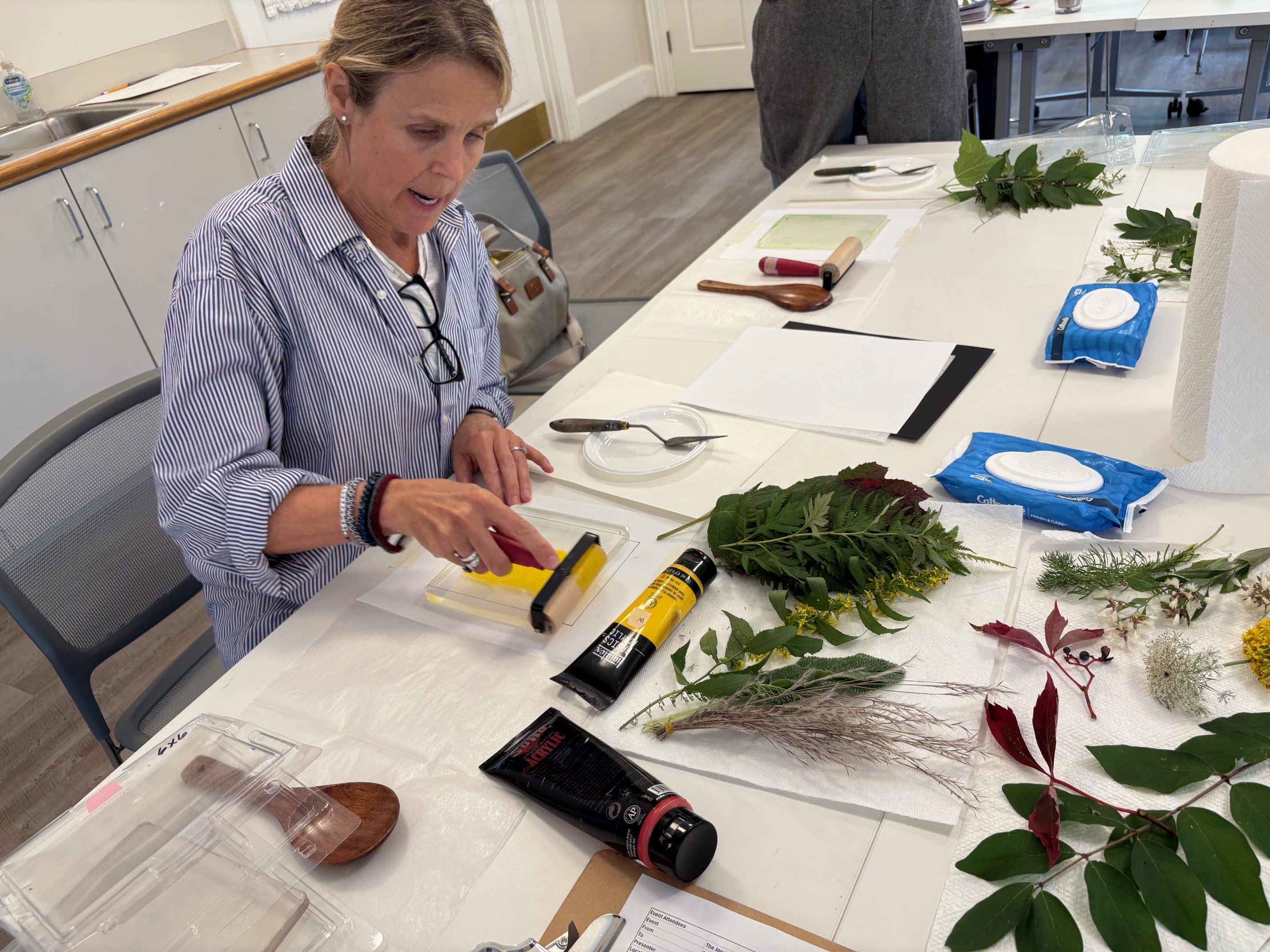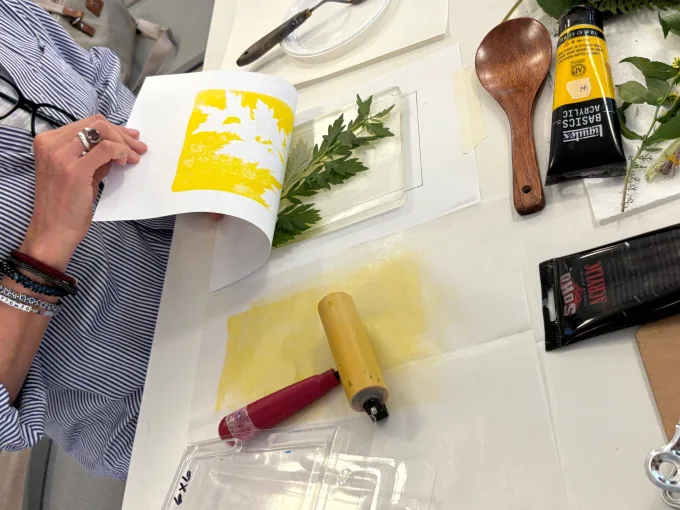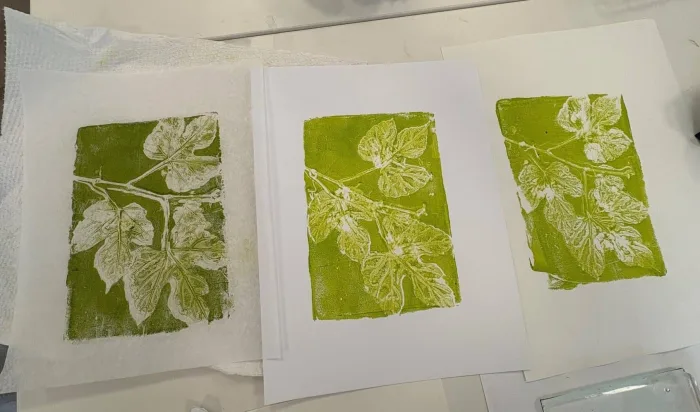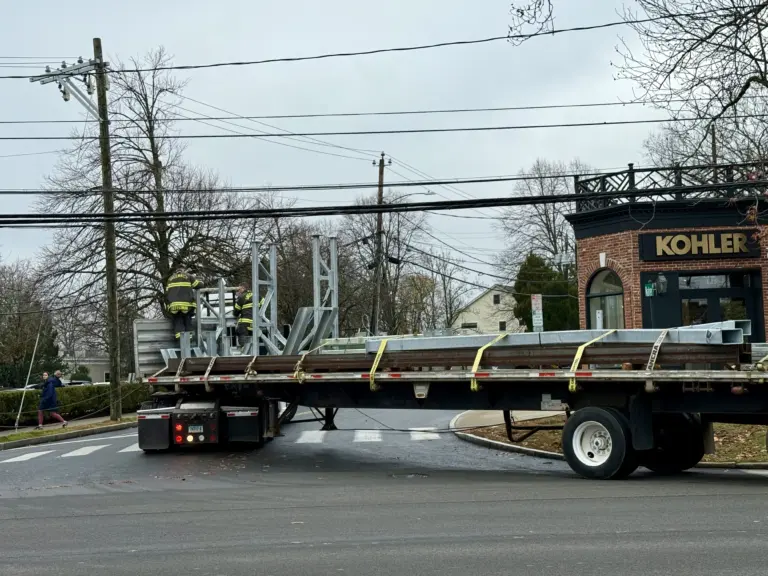On my watch: Learning the Joy of Botanical Print Making with Mary Scott Himes

By Anne W. Semmes
For the last two Wednesday afternoons Mary Scott Himes, the talented wife of our Greenwich based U. S. Congressman Jim Himes has opened the door to the art and beauty of creating botanical prints, and this writer was privileged to attend the first Wednesday on October 7, as held from 1-3 at the Perrot Memorial Library. And the learning was all free!
Upon arrival Mary had laid it all out for the eight of us, some botanical choices from her backyard “beloved weeds,” and an array of acrylic paint colors, and paint brushes. On two long tables she placed for each of us a rubbery, rectangular gel plate secured on paper we would paint with a dab of paint, then using a hand rolling brayer to spread the paint across the plate. “One of the most important things” she instructed, was “don’t put too much paint on the gel plate… because it’ll slide around and you won’t get a clean print…and this paint dries really fast.”
With our chosen “weed” we would arrange it on the painted plate, then place atop the weed a provided sheet of paper, “and the important thing is you do not want this paper to move because it’ll give you a mushy print. So, hold it down with one hand.” And “burnish it with your hand, and if that weed has a stem, use your fingers to press down around it…to get into the nooks and crannies of that stem.”
So, I chose a sage green paint and a stem of three large petals. I burnished that paper over that arranged weed on that sage green painted gel plate. And when I peeled off the imprinted paper, it was beautiful! But there came another choice. “This is called the ghost,” tells Mary, by removing the botanical, then placing a tissue-like paper over the now petals-imprinted gel plate, burnishing it, then a new print peeled back – a ghost print that appeared even more beautiful. What a joy to see! As in the title of her class, I was experiencing “The Joy of Botanical Printmaking!”
This path to the sharing of joy had come to Mary at a tough moment in her life – she shared it with us. She is a breast cancer survivor as of four plus years ago. Having worked in restaurant design – she has a BA in history/Art History, and a BFA in Environmental Design from Parsons School of Design, she’d had to step away from “making stuff. I had to go through a lot of treatments.” But what came to her was “this incredible need to create,” with an inspiration. She’d met up with Amy Zabin “teaching music therapy at the Stamford Bennett Canter Center” who suggested she teach art to others undergoing treatment. “Why not” was Mary’s response. “Amy gave me the courage to reach out… I just do the printmaking. I don’t get paid – I just do it as a volunteer.” And she “loves doing this.”

Meanwhile, all eight of us are experimenting with different colors, different plants, with Mary moving amongst us with suggestions. Next to me is Wendy creating a number of winning prints with her chosen weeds and colors. Some women have brought their own botanicals to use.
Onto the next table, Mary brings a set of stencil designs we can also use on our gel plates, and she points to a purple print of hers attached on the wall. “So, this purple one is a ghost print. It really shows it’s the positive, not the negative of the stencil.” To demonstrate, she chooses yellow paint to make the botanical print. “I roll the yellow on; I put the plant on top and then I take away the print right?” She then places the print on the imprinted gel. “It’s hard to burnish it when there’s paint because there’s friction there. I’m holding it down really, really, hard.” The result is a most colorful and evocative ghost print.
“You can do these kinds of layers as many times as you want,” she continues. “It’s so cool. So that’s called over-printing. You’re just layering… It dries really fast…You can use different colors, you can overlay with a different plant… And if you want to totally change your palette, you’re going to wipe off the gel plate.” She adds, “Some colors when they interact with other colors can shift. A pink can look more blue depending on what it’s sitting next to.”
With her guidance each table would be filled with colorful botanical prints, some showing stenciled silver leaves, some with multiple color variations. But the two-hour session was coming to a close, and Wendy next to me was leaving, with her impressive spread of prints. “This has been wonderful and exciting,” she tells Mary, “Thank you so much.” Agreed! Thank you, Mary!





